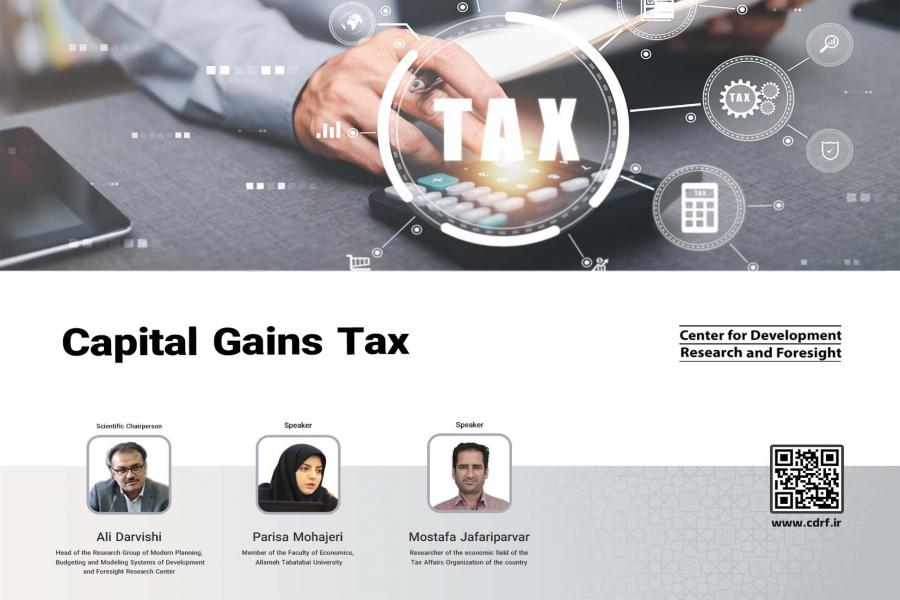
-
بررسی آییننامهها و دستورالعملهای برنامه هفتم پیشرفت
-
بررسی عوامل موثر بر افزایش تصادفات و تلفات جادهای و سوانح رانندگی و دادهکاوی تلفات انسانی
-
سازماندهی و بازآرایی فضایی آموزش عالی کشور
-
به روز رسانی سند ملی آمایش سرزمین
-
انجام مطالعات مناطق آزاد به عنوان نواحی پیشران اقتصادی کشور
-
اصلاح ساختار بودجه و پیاده سازی نظام یکپارچه مدیریت اطلاعات مالی دولت (IFMIS)

The scientific-specialized conference titled "Capital Gains Tax" was held at the Center for Development Research and Foresight with the presence of notable speakers such as Dr. Ali Darvishi, Head of the Department of New Planning, Budgeting, and Modeling Systems of the Center for Development Research and Foresight, Dr. Parsia Mohajeri, Faculty member at Allameh Tabataba'i University, and Mr. Mostafa Jafaripoor, Researcher at Iranian National Tax Administration.
In the opening remarks, Dr. Darvishi stated that the projected budget law of Iran for 2022 anticipates that tax collection will constitute more than 80% of the country's expected revenues of 699 trillion tomans (561 trillion tomans). He added, "This implies that the government's expenses will exceed 999 trillion tomans by the end of the year, resulting in a negative operational balance of approximately 300 trillion tomans." To address this shortfall, the government is seeking to increase tax revenues, a significant portion of which will come from identifying new tax bases, Dr. Darvish asserted.
As the second speaker, Dr. Mohajeri pointed out that the government and parliament's approach to implementing the capital gains tax plan is based on several strategies, including promoting productive investment and production, regulating cash inflows into volatile markets such as housing, automotive, gold, and currency, preventing abrupt price hikes, reducing reliance on oil revenues, minimizing economic vulnerabilities, and encouraging greater public participation in tax payments. However, there are concerns about this taxation method. She further added, "In the current structure of the country's direct taxation system, existing tax collection capacities have been overlooked due to factors such as inefficiencies in the capital gains tax system and widespread tax exemptions."
The faculty member at Allameh Tabataba'i University said "It is expected that the Capital Gains Tax (CGT) will be considered either concurrently with or after the Personal Income Tax (PIT)." As an example, she put forward that the income from interest, distributed profits, and real estate (rental income) are subject to exemptions that have a negligible share of indirect taxation. Therefore, she concluded that it is necessary to fully implement the personal income tax system before proceeding with the implementation of the capital gains tax law.
As the last speaker, Mr. Jafarpoor referred to another significant concern. He added this concern is that the capital gains tax law lacks substantive content and neglects the social consequences of its implementation. The media and society perceive the capital gains tax law as affecting everyone equally, which could exacerbate existing economic and social challenges. However, in reality, there are extensive exemptions in the law.
In the end, Dr. Darvishi, as a scientific chairperson summarized the below points and recommendations so that all online and in-person participants could have a comprehensive view of the conference.
- The primary priority should be to eliminate unnecessary exemptions in the direct taxation system.
- The implementation of a wealth tax on individuals should be pursued after addressing these exemptions.
- The capital gains tax should be implemented at a fixed rate.
- Maintenance and repair costs should be considered in tax collection.
- The tax base should be adjusted for inflation.
- Issues related to stocks should be addressed in the law.



